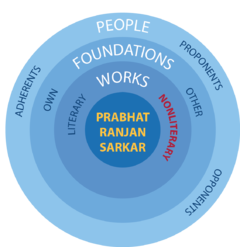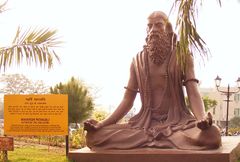Ahimsa
| This article is actively undergoing a major edit for a short while. To help avoid edit conflicts, please do not edit this page while this message is displayed. This page was last revised at 08:08, 24 November 2013 (UTC) (10 years ago). Please remove this template if this page hasn't been edited in several hours. If you are the editor who added this template, please be sure to remove it or replace it with {{Under construction}} between editing sessions. |
|
Ahimsa (Sanskrit: अहिंसा; IAST: ahiṃsā, Pāli:[1] avihiṃsā) is a term meaning benignity, non-injury. The word is derived from the Sanskrit root hiṃs – to strike. Hiṃsā is injury or harm. A-hiṃsā is the opposite.[2][3]
Ahimsa is one of the cardinal virtues[4], the first of ten principles in the ancient tantric/yogic system of morality, Yama-Niyama. As such, it is also an important tenet of major Indian religions (Buddhism, Hinduism, and Jainism). Over the years, Ahimsa has been interpreted in many different ways. In his book, A Guide to Human Conduct, Sarkar analyzes the concept of Ahimsa and some popular interpretations of the term.[5]
Etymology
The word Ahimsa - sometimes spelled as Ahinsa[6][7] - is derived from the Sanskrit root hiṃs – to strike; hiṃsā (or hiḿsá in Sarkar's Roman Sanskrit) is injury or harm, a-hiṃsā is the opposite of this, that is benignity or non-jury.[6][8] According to Sarkar, "Ahiḿsá means not inflicting pain or hurt on anybody by thought, word or action."[5]
There is a debate on the origins of the word Ahimsa, and how its meaning evolved. Mayrhofer as well as Dumot suggest the root word may be han which means kill, which leads to the interpretation that ahimsa means do not kill. Schmidt as well as Bodewitz explain the proper root word is hiṃs and the Sanskrit verb hinasti, which leads to the interpretation that ahimsa means do not injure, or do not hurt. Wackernagel-Debrunner (and Sarkar) concur with the latter explanation.[9][10]
History
| Yama (Restraint) | |
|---|---|
| Ahiḿsá (Benignity) | Thinking, speaking, and acting without inflicting pain or harm on another |
| Satya (Benevolence) | Thinking and speaking with goodwill |
| Asteya (Honesty) | Not taking or keeping what belongs to others |
| Brahmacarya (Ideation) | Constant mental association with the Supreme |
| Aparigraha (Frugality) | Non-indulgence in superfluous amenities |
| Niyama (Regulation) | |
| Shaoca (Cleanliness) | Physical and mental purity, both internal and external |
| Santośa (Contentment) | Maintaining a state of mental ease |
| Tapah (Sacrifice) | Acceptance of sufferings to reach the spiritual goal |
| Svádhyáya (Contemplation) | Clear understanding of any spiritual subject |
| Iishvara Prańidhána (Dedication) | Adopting the Cosmic Controller as the only ideal of life and moving with ever-accelerating speed toward that Desideratum |
| Intent is primary, but both intent and action should conform if possible. | |
The concept of ahimsa first arose as an ethical precept in the indigenous tantric tradition of ancient India. Over time, the concept of ahimsa made its way into Vedic texts with varying interpretations. When the philosopher wikipedia:Patanjali (circa 200-400BCE) systematized tantra into what is popularly known as Aśt́áuṋga Yoga (eight-limbed yoga) or Rája Yoga (the king of yogas), ahimsa was the first principle of his first element of yoga (Yama).[11]
References
- ^ Rune E. A. Johansson (6 December 2012) Pali Buddhist Texts: An Introductory Reader and Grammar Routledge p. 143 ISBN 978-1-136-11106-8 retrieved 8 August 2013
- ^ Mayton, D. M., & Burrows, C. A. (2012), Psychology of Nonviolence, The Encyclopedia of Peace Psychology, Vol. 1, pages 713-716 and 720-723, Wiley-Blackwell, ISBN 978-1-4051-9644-4
- ^ [Encyclopedia Britannica], see Ahimsa
- ^ Stephen H. Phillips & other authors (2008), in Encyclopedia of Violence, Peace, & Conflict (Second Edition), ISBN 978-0123739858, Elsevier Science, Pages 1347–1356, 701-849, 1867
- ^ a b Anandamurti, Shrii Shrii (2004) A Guide to Human Conduct ISBN 9788172521035
- ^ a b Sanskrit dictionary reference
- ^ Standing, E. M. (1924). THE SUPER‐VEGETARIANS. New Blackfriars, 5(50), pages 103-108
- ^ A Hindu Primer, by Shukavak N. Dasa
- ^ Henk Bodewitz (in Jan E. M. Houben, Karel Rijk van Kooij, Eds.), Violence Denied: Violence, Non-Violence and the Rationalization of Violence in South Asian Cultural History, ISBN 978-9004113442, Brill Academic Pub (June 1999), see Chapter 2
- ^ Walli pp. XXII-XLVII; Borman, William: Gandhi and Non-Violence, Albany 1986, p. 11-12.
- ^ Patañjali: Yoga Sutras, Sadhana Pada 30.

